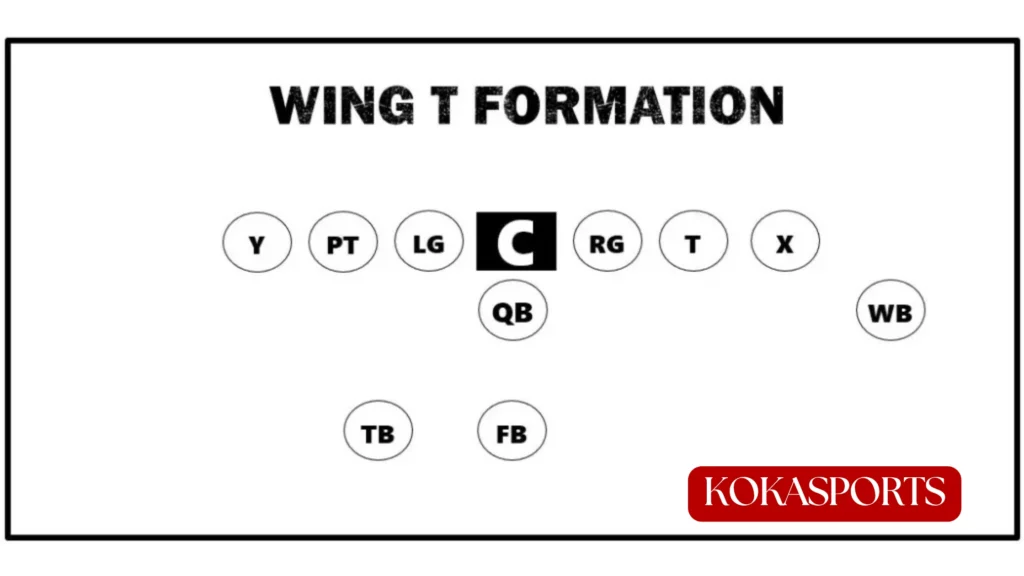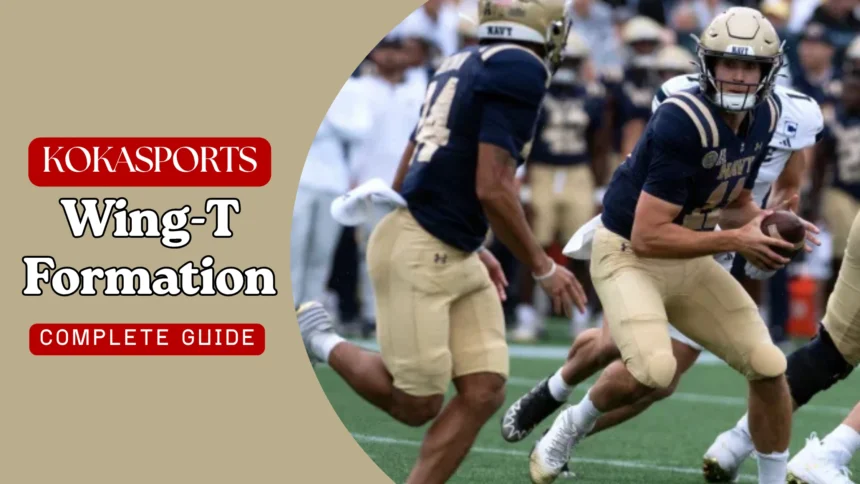The Wing-T formation has stood the test of time as one of American football’s most reliable and effective offensive systems. From the University of Delaware to countless Pop Warner leagues across the country, this time-tested formation continues to produce winning results. What makes the Wing-T offense so special is its ability to teach fundamental football skills while keeping defenses constantly guessing through clever misdirection and precise timing.
In this comprehensive guide, you’ll discover everything you need to know about running the Wing-T. Whether you’re a youth football coach preparing for your first season or an experienced head coach looking to add new dimensions to your playbook, you’ll find practical strategies and deep insights that can transform your team’s performance. We’ll break down the core run plays, explore blocking techniques, and show you how this formation creates opportunities for success at every level of play.
What Is the Wing T Formation?

The Wing T formation is a powerful offensive system that relies on timing, deception, and disciplined execution. At its core, this formation places a wingback (WB) positioned just outside and slightly behind the tight end (TE), creating a unique alignment that sets up countless possibilities for ball movement. The quarterback lines up under center, with a fullback directly behind him and a halfback in the deep backfield position.
The genius of this system traces back to innovative football coaches who understood that moving players before the snap could create confusion and hesitation in defensive schemes. The traditional Wing-T emerged as coaches realized they could use motion and fake handoffs to make multiple plays look identical at the start, forcing defenders to commit before they could identify the true ball carrier.
What separates the Wing-T from simpler systems like the single wing or double wing is its sophisticated use of backfield action. While the double wing relies more on power blocking, the Wing-T offense combines power with finesse, using pulling linemen and carefully timed fake handoffs to create openings at the point of attack.
Read More: How Many Players Are in American Football Team? Full NFL Roster and Football Team Breakdown
The Philosophy Behind the Wing-T Offense
The strategic mindset of the Wing-T offense centers on a simple but powerful principle: make every play look the same until the last possible moment. This philosophy forces defensive players to respect every option, which naturally creates gaps and opportunities for your running backs to exploit.
Youth football programs particularly benefit from this approach because it teaches young players to focus on their individual assignments rather than trying to improvise. Each player has a specific role on every play, whether they’re serving as a blocker, carrying the ball, or selling a fake to freeze defenders. This structure builds confidence and helps young athletes understand how teamwork creates success.
The Wing-T formation also emphasizes discipline in the backfield. Your QB must master the art of ball handling, making every handoff look convincing whether it’s the real exchange or a carefully executed fake. The fullback, halfback, and wingback all move with purpose, creating a symphony of motion that overwhelms defensive coordination. When executed properly, even defenders who study your playbooks struggle to react quickly enough to stop the attack.
Breaking Down the Wing T Formation Setup

Understanding player positioning is essential for mastering this offense. Let’s examine each position and its critical responsibilities.
Quarterback (QB)
The quarterback serves as the orchestrator of every play in the Wing-T. Unlike spread offense systems where the QB often throws 30-40 passes per game, the Wing-T quarterback focuses primarily on ball handling and decision-making at the line of scrimmage. Your QB must execute smooth fakes, make quick reads of defensive fronts, and deliver precise handoffs to the correct ball carrier.
Fullback (FB)
The fullback in this system is your power runner and primary inside threat. On the fullback trap and similar plays, the FB reads blocks from pulling linemen and hits holes with authority. This position requires a physical runner who can gain tough yards in short-yardage situations while also serving as a lead blocker on sweep plays to the perimeter.
Wingback (WB)
The wingback position is unique to this formation and creates many of its advantages. Aligned just outside the TE on the strong side of the formation, the WB can motion across the formation before the snap, creating numerical advantages and forcing defenses to adjust on the fly. This player needs good speed and vision to execute the buck sweep and jet sweep effectively.
Offensive Line
Your offensive line and tight end create the foundation for success. Guards and tackle positions must master multiple blocking techniques, including down blocks, trap play assignments, and pulling to lead runners to the edge. The offensive linemen often work in unbalanced sets, with an extra lineman or TE on one side of the formation to create power at the point of attack.
Key Components of the Wing-T Offense
Several core principles define successful Wing-T execution:
Motion and Timing: The wingback motion forces defenses to adjust their alignment and assignments right before the snap. This creates uncertainty and often causes linebacker hesitation at critical moments.
Misdirection: By running a series of plays that start with identical backfield movement, you force defenders to hold their positions longer, which creates running lanes. The fake handoff becomes as important as the real one.
Multiple Ball Carriers: Unlike offenses that rely on one star player, the Wing-T offense distributes carries among the fullback, tailback, and wingback. This keeps defenses from keying on a single threat.
Balanced Attack: While primarily a running offense, the Wing-T includes effective pass play options through play action and quick screens. This balance prevents defenses from committing too heavily to stopping the run.
The Wing T Formation Playbook: Core Run Plays
The Buck Sweep
The buck sweep is the signature play of any Wing-T playbook. This play epitomizes everything the offense represents: coordinated blocking, perfect timing, and devastating effectiveness when executed correctly.
Here’s how the buck sweep develops: The wingback goes in motion toward the strong side just before the snap. As the ball is snapped, both guards pull toward the playside, leading the wingback around the edge. The quarterback executes a reverse pivot, handing off to the WB who follows the pulling linemen around the end. Meanwhile, the fullback and halfback run complementary paths that look similar, selling potential fake handoffs that freeze inside defenders.
The beauty of this play lies in its blocking angles and the way it creates a numbers advantage at the edge. When your guards execute their pulls correctly, they arrive at the defensive end and outside linebacker with perfect timing, creating a clear path for your ball carrier.
The Fullback Trap
The fullback trap serves as the perfect complement to the buck sweep. While the sweep attacks the edge, the trap hits inside where defenses least expect it. On this base play, your backside guard pulls across the formation to trap an unsuspecting defensive lineman, while your fullback reads the block and accelerates through the opening.
The key to the trap play is selling the sweep action. Your wingback still goes in motion, and your QB executes the same footwork as the sweep, making defenders respect the outside threat. When they flow laterally to stop the sweep, the trap opens up naturally in the play-side guard‘s original position.
The Counter and Power Series
The buck series extends beyond the sweep and trap with a sophisticated counter game. These counter plays punish aggressive defenders who chase the initial flow of the backfield action. Your HB or halfback takes a path opposite to the initial motion, following a pulling guard back against the defensive flow.
These plays require patience from your running backs and precise timing from your offensive line. When defenders commit to stopping your primary threats, the counter becomes an explosive big play opportunity.
The Belly and Down Series
For short-yardage situations and goal-line scenarios, the belly and down series provides power-oriented run plays that attack defenders straight ahead. These plays typically involve your fullback reading down blocks from your tackle and TE, hitting the hole quickly before defenders can plug gaps.
Wing-T Pass Plays: Adding Variety to the Offense

While the Wing-T is primarily a running attack, incorporating pass plays keeps defenses honest. The waggle is particularly effective, using play action to freeze defenders while the quarterback rolls to the weak side, away from the flow of the run game.
Play action passes work naturally in this system because defenders must respect your run threats. When your fullback dives into the line on a fake, linebackers instinctively step forward, creating throwing lanes behind them. Simple routes from your wide receiver and tight end often produce easy completions when defenses overcommit to stopping the run.
The rocket sweep can also serve as a quick passing alternative, with your wingback catching a quick toss and attacking the edge immediately. This play combines elements of running and passing, making it difficult for defenses to classify and prepare against.
Blocking Schemes in the Wing T Formation
Your blocking scheme determines whether plays succeed or fail. The Wing-T employs several distinct blocking techniques:
Down Blocking: Linemen block down toward the center, creating movement and sealing inside gaps.
Trap Blocking: A pulling guard or tackle traps an unsuspecting defender, usually a defensive end or defensive tackle who penetrates upfield.
Pull Blocking: Guards and sometimes tackles pull to lead runners to the perimeter, arriving at the point of attack with proper blocking angles.
Teaching these techniques to youth football players requires patience and repetition. Start with basic down blocks, then progress to pulling and trapping as players master fundamental footwork and hand placement.
Why the Wing T Formation Dominates Youth Football
The Wing T formation excels at the youth football level for several compelling reasons. First, it teaches fundamental skills that translate to any offensive system players encounter later in their football careers. Young players learn proper backfield timing, blocking techniques, and the importance of executing their assignments with precision.
Second, this offense doesn’t require exceptional athletes to succeed. While having talented players certainly helps, the Wing-T can produce winning results with average athletes who execute well. This makes it ideal for high school football and Pop Warner programs where talent levels vary significantly.
Third, the system builds team unity. Every player matters in the Wing-T offense, from your starting tackle to your blocker who never carry the ball. This inclusivity creates strong team chemistry and teaches young players valuable lessons about contributing to collective success.
Football teams that run the Wing-T consistently compete for championships. The system’s proven success at every level, from youth football to college football, demonstrates its enduring effectiveness. Even as modern football has evolved toward the spread offense, many successful programs continue using Wing-T principles because they work.
Coaching the Wing-T Offense Effectively
Installing the Wing-T formation requires a systematic approach. Begin with the buck sweep as your foundation play, teaching every position’s responsibilities in detail. Once players understand the sweep, add the buck trap to create your first complementary pairing. As execution improves, gradually introduce counter plays and pass play options.
Practice drills should emphasize timing and ball handling. Your quarterback needs countless repetitions executing fakes and handoffs until these movements become automatic. Backfield players must practice their paths until they can run them with their eyes up, reading blocks rather than worrying about footwork.
Common mistakes include poor timing on pulls, wingback motion starting too early or late, and quarterback fakes that don’t look realistic. Film study helps identify these issues, allowing coaches to make specific corrections that improve overall execution.
Conclusion: Why Every Coach Should Know the Wing T Formation
The Wing T formation is more than an offensive system – it’s a complete philosophy that emphasizes teamwork, discipline, and fundamental excellence. From Pop Warner to the high school level, the Wing-T provides a proven framework for developing players and winning games.
Football coaches who master Wing-T principles gain insights applicable to any offense. The concepts of timing, misdirection, and complementary play design transcend specific formation variations, making this system essential knowledge for every coach’s foundation.
Success comes from consistent execution rather than complexity. Master the core run plays, teach sound blocking techniques, and trust the system to create opportunities. The Wing T offense has produced winners for decades and will continue dominating for generations to come.
FAQs
What is a Wing T formation?
An offensive system with a wingback outside the tight end that uses motion and misdirection to create running lanes.
What is the difference between Power T and Wing T?
Power T uses straight-ahead power running, while Wing-T relies on misdirection, pulling guards, and deception.
How to stop wing T offence?
Maintain gap discipline, read guards not backfield flow, and don’t chase motion or bite on fakes.
What is the Wing T jet formation?
The wingback takes fast motion and receives a quick toss at full speed to attack the edge.




